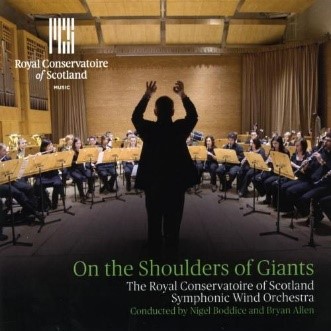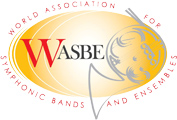Welcome to 
NEWS
REPERTOIRE IDEAS FOR 2020
In two weeks I shall be off to Chicago to the Mid-West. I hope to find some good repertoire for any gigs in 2020. Browsing through old tapes and CDs reminds me of several great neglected pieces which I would love to conduct, and I have written about some of them below:
Three Folk Tunes - Gustav Holst
Marching Song - Gustav Holst
Pageant of London - Frank Bridge
English Dance Suite - John Gardner
A Plain Man’s Hammer - Martin Dalby
Venetian Spells - Martin Ellerby
New World Dances - Martin Ellerby
Overture 1912 - Iain Hamilton
8 RNCM WIND ORCHESTRA RADIO APPEARANCES THIS FALL
What is particularly exciting for me this Autumn/Fall is to have no less than 8 performances by the RNCM Wind Orchestra played on BBC Radio 3. I hear of other performances in USA, in Australia on ABC Classic and Colin Touchin writes from Hong Kong: “I’ve played tracks of this and other RNCM discs in my In Touch with Music weekly wind band hour on RTHK Radio 4. Listen out on Radio 3 for The Power of Rome and the Christian Heart on Election Day.

BRITISH WIND BAND CLASSICS
Holst Suite for Military Band No.1 in Eb
Essential Classics 10th October
Vaughan Williams Toccata Marziale
Sunday 3rd November
Recorded 28/29 March 1998, New Broadcasting House

THE WIND MUSIC OF EDWARD GREGSON
Gregson Festivo
In tune Mixtape 28th October

FRENCH WIND BAND CLASSICS
Saint Saens Occident et Orient
Essential Classics 26th November

GRAINGER WORKS FOR WIND ORCHESTRA
Grainger Over the Hills and Far Away
Breakfast 20th November
GRAINGER COMPOSER OF THE WEEK
Lincolnshire Posy 11th December
RNCM WIND ORCHESTRA CELEBRATE ELECTION DAY
Power of Rome and the Christian Heart 12th December
Irish Tune from County Derry 12th December.
BRIEF OBITUARY OF MARTIN DALBY

Martin Dalby, composer, music producer and former head of music BBC Scotland. Born: 25 April 1942. Died: 25 October 2018, aged 76.
I have just realised that Martin Dalby, Scottish composer (1942-2018) died last year, sad but an excellent reason for us all to consider programming his magnificent work A Plain Man's Hammer (1984), here in a big performance by the Royal Conservatoire of Scotland conducted by Nigel Boddice. Ctrl and Click below to follow link. https://www.youtube.com/watch?v=oDL2NXByzxg
Commissioned by the Dunbartonshire Wind Ensemble with funds provided by the Scottish Arts Council.
First performance by the Dunbartonshire Wind Ensemble, conductor Trevor Green, at the Kelvin Hall, Glasgow, on 19 June 1985.
MARTIN DALBY was born in Aberdeen in 1942. He was educated at Aberdeen Grammar School and in 1960 won a Foundation Scholarship to the Royal College of Music in London where he studied composition with Herbert Howells and viola with Frederick Riddle. In 1963 the Octavia Prize and a Sir James Caird Travelling Scholarship enabled him to spend two years in Italy where besides composing he played the viola with a small Italian Chamber Orchestra. In 1965 he was appointed as a music producer to the BBC's newly formed Music Programme (later to be Radio 3.) In 1971 he became the Cramb Research Fellow in Composition at the University of Glasgow and in 1972 returned to the BBC as Head of Music, Scotland. In 1991 he relinquished this post in order to pursue a more creative role. His works for Wind Orchestra are:
1984 A Plain Man’s Hammer
1990 Flight Dreaming
WORKS FOR THE COMMUNITY AND SCHOOL BAND
The Boherbuoy Band was formed in 1850An evening spent working with their very talented conductor, Andrew Jordan, on Fergal Carroll’sBlackwater,set me thinking of unusual and challenging repertoire for community and school bands. Of course the Holst Suites are essential core material, but why not explore other works, even by Holst.THREE FOLK TUNES (1905) GUSTAV HOLST ed. Binney Published Maecenas
https://www.youtube.com/watch?v=4UHsq1pmZwQ
Holst's first original wind band work which later became the basis for the first movement of his Second Suite in F, is published by Maecenas (2005) in a new user-friendly edition combining authenticity, accessibility and practicality. We keep the original small band scoring to encourage totally authentic performance, while sympathetically doubled extra parts, clearly shown as optional, expand the forces to suit the needs of more normal community, concert and military bands. Classic core repertoire. Grade 3
MARCHING SONG (1906) GUSTAV HOLST arr for military band by Holst
https://www.youtube.com/watch?v=g5MxX_nJIqM
Marching Song played by the North Texas Wind Symphony conductor Eugene Miraglio Corporon
A year after the Three Folk Songs, Holst wrote Two Songs Without Words for small orchestra, and they were first performed at the Royal College of Music conducted by the composer, and dedicated to Ralph Vaughan Williams. In 1929, the march was scored for small band; by omitting all of the optional extra parts, the work can be played by as few as 25 players..
PAGEANT OF LONDON (1911) FRANK BRIDGE
https://www.youtube.com/watch?v=RcEIPiJdvQI
Loureiros Band Workshop conductor Yibin Seow

A magnificent alternative to the repertoire of Holst and Vaughan Williams from the early 20th century.
l. Solemn March; Richard 111 leaving London
ll. First Discoveries: Introduction – Pavane – La Romanesca (Galliard)
III. March: Henry VIII entering London
The 1911 Festival of Empire, a great exposition in which all of the overseas dominions of the British Commonwealth took part, was held in conjunction with the coronation of King George V. The Festival took place at Crystal Palace and the centre of attraction was the Pageant of London, an enormous enterprise. Some 15,000 performers, representing all walks of life, took part, and by the time the pageant had finished its four month run, it had been seen by over four million people. In all, twenty composers contributed to the Festival including Holst, Vaughan Williams, Haydn Wood and Balfour Gardiner.
ENGLISH DANCE SUITE, OP.139 (1977)
http://www.musicpdf.net/Catalogue4.html
Catalogue 4 of MUSICPDF includes English Dances SuiteB by John Gardner
At last this magnificent score, written for the Royal Military School of Music at Kneller Hall, is available for purchase. This beautiful work was all but forgotten after its first performance at the Royal Albert Hall in 1977. The second performance, by the Royal Northern College of Music Wind Orchestra, conducted by Clark Rundell in June 1992 restored two of the seven movements which had been cut from the first performance. This is a superbly crafted work in a traditional - but completely non-derivative - style. Though the first movement clearly looks back to the Chaconne of Holst's Eb suite, the remainder of the work uses dance styles as opposed to folk tunes. We hear no marches composed of folk songs but rather Renaissance and Maritime dances. Gardner's orchestration is expert, but his real genius lies in the instruments he leaves out. The welcome sound of Harmoniemuik in the almost Mozartian Courante is every bit as striking as the dynamic Volta for the brass alone.
Overture 1912 (1963) - Iain Hamilton (1922- 2000)
The Light Overture "1912" was originally written in 1958 for orchestra, and was re-scored for concert band in 1963 whilst the composer was working at Duke University in the United States. It is dedicated to "the memory of Dan Leno of Drury Lane". Iain Hamilton adds a note to the wind versionc A portentous introduction, muted trumpet theme over clashing tonal centres of A minor and augmented triads on Eb, leads to the main allegro, an energetic cockney piccolo tune with a hint of a rumba in its coda. This is treated in a variety of keys, rhythms and orchestrations and leads very properly to a second idea in A minor, also the subject of variations. The trumpet theme of the introduction turns out to be a waltz, which in turn gives way to a foxtrot. There is a regular recapitulation during which we find that most of the material works equally well either separate
Sound Cloud recording
THIS MONTH’S COMPOSER
I plan to resume a feature of past web pages, and look monthly at one particular composer and his works. For this month, I have chosen MARTIN ELLERBY, with a commentary on his earlier works and programme notes for two works written for me.
Official website martinellerby.com

Born in Worksop in 1957, he studied with joseph Horovitz, W.S.Lloyd webber, and Wilfrid Joseph, becoming the composer’s amanuensis. He has written in most forms, including choral music, chamber works, and a great deal of music for brass band and wind band.
Ellerby’s earliest essay for wind was the evocative Tuba Concerto (1988, Maecenas). It was followed by Paris Sketches, still his most popular work, and Dona Nobis Pacem (1995, Maecenas) a heartfelt elegy for the heroes of the Second World War, premiered at Symphony Hall, Birmingham. More ambitious is the Symphony (1997, Studio), commissioned for the 1997 BASBWE Conference, and a wind version of his Euphonium Concerto (1996, Studio), while his Venetian Spells (1997 Studio) recalls the pastiche qualities of Paris Sketches, evoking the music of Gabrieli, Vivaldi and other Italian masters with telling use of both harp and harpsichord. New World Dances (1998, Studio) is a transcription of a brass band original, designed for a youth band tour of USA and readily accessible. More recently there seems to have been a divergence between his more serious works, Meditations and Via Crucis, and the lighter side, which includes the Clarinet Concerto and the educational piece The Big Easy Suite. In 2005 he received a commission from Her Majesty’s Band of the Coldstream Guards for a work entitled The Cries of London, and followed this up in in 2009 with Royal Windsor Portraits, premiered before the Queen in a private concert at Windsor. Other works include the Cinnamon Concerto commissioned by Nobuya Sugawa of the Kosei, and the Mass of St Augustine commissioned by Matthew George. In 2010 he completed a wind band setting of Karl Jenkins’ The Armed Man; A Mass for Peace which was premiered by Yorkshire Wind at York Minster, Leeds Armoury and Coventry Cathedral. More recent works include Cane River Murals, Symphony in Five Movements, Five Manx Romances, Gallipoli ‘100’ Suite,
Programme notes below on two works written for me at the Royal Northern College of Music.
VENETIAN SPELLS
1. Concertante (Antonio's Allegro)
2. Pas de Deux (Igor's Lament)
3. Vesters (Claudio's Sunset)
4. Festivo (Giovanni's Canon)
https://www.youtube.com/watch?v=SydRgnmtnZc
https://www.youtube.com/watch?v=3Q6CgueLFNQ
Banda Sinfónica de Santa Maria da Feira Concerto no Europarque
Venetian Spells was commissioned by timothy Reynish in celebration of his 60th birthday. The work was premiered in 1998 by the Edinburgh Concert Band at the Royal Northern College of Music in Manchester, United Kingdom.
The work is cast in four movements, each of which pays musical homage to a composer associated with the city of Venice. The first movement, Antonio's Allegro, contains sections of music which are reminiscent of the Baroque composer Antonio Vivaldi, who was born in Venice. The second movement emulates the style of the great Russian composer Igor Stravinsky, who is buried in the island cemetery of San Michele in Venice, along with his friend and collaborator, the impresario Sergei Diaghilev.
The third movement is dedicated to the Renaissance composer Claudio Monteverdi, who spent the most productive years of his compositional life in Venice as the music director at St. Mark's Basilica, and died in Venice as well, in the year 1643.
The final movement is dedicated to Giovanni Gabrieli, the foremost composer of the Venetian School and also a music director at St. Mark's prior to MonteverdiAccording to Ellerby, "The finale is a celebration of the great city in a festival time ... it builds to an epic conclusion of which Gabrieli would have been thoroughly ashamed!"
- Program Note from Knightwind Ensemble (Milwaukee, Wisc)
NEW WORLD DANCES
For Timothy Reynish and the Royal Northern College of Music Wind Orchestra.
https://www.youtube.com/watch?v=UekvhmL5e7I
>HOFSTRA UNIVERSITY
Cast in three short movements, the work endeavours to recreate the pioneering spirit of the journey across America (the then 'New World') as this vast continent was opened up and its wonders exposed. The three dance episodes that make up the suite are symbolic in an analogous sense to this 'reaching' principle: the first -- Earth Dance -- is a vigorous overture, pushing out the frontiers; the interlude – Moon Dance -- contemplates the huge distances to be crossed, and Sun Dance represents the realisation of the American dream, rhythmic and full of energy. Written in affectionate tribute to America and its people, New World Dances was rather symbolically completed on July 4th!
- Program Note by publisher
CONFERENCES IN 2020
CBDNA FEBRUARY 17 – 20 20 – 24 2021
UNIVERSITY OF GEORGIA, ATHENS, USA
Our next national conference will take place in Athens, GA, hosted by Cynthia Johnston Turner and her staff at the University of Georgia Hodgson School of Music February 17-20, 2021.
WASBE JULY 20 – 24 2021 PRAGUE

The participation of 15 symphonic wind bands is planned for the main concert programme. Interested symphonic wind bands from around the world may wish to contact the WASBE Board or the Local Organizing Committee at loc@wasbe2021.com and submit 2 recordings of their live performance not older than 1 year prior to the submission.

 Visit the World Association for Symphonic Bands and Ensembles website
Visit the World Association for Symphonic Bands and Ensembles website